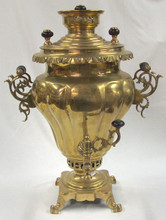Although the Ministry of Culture in Russian now prohibits the export of Russian antiques over 100 years old, we were active during the early 1990's in Russia when the rules were less prohibitive, and the "100 year rule" still could encompass pre-revolutionary works. So we were able to source and bring out a number of works that are now on sale in our store that would be impossible to get in Russia today. It is important to also remember that families who fled Russia during and after the revolution took with them a treasure trove of Russian art and collectibles, including icons, pieces of Faberge, and collections of fine art. These pieces often turn up in estate sales in cities where the expatriated Russian settled in America; and the owners of the Russian American Company are always searching to acquire the best available.
 First appearing in the eighteenth century as a teakettle with a chimney, the Russian samovar was fashioned, over many decades, into a host of forms, some preserving the classical shapes of eighteenth-century vases, others made with detachable legs to meet the needs of travelers who liked to take their tea in their carriages or on the train. The detailing on the samovar also changed over time- the tap and handles made in the shapes of twigs, dolphins, and curved abstract stalks.
First appearing in the eighteenth century as a teakettle with a chimney, the Russian samovar was fashioned, over many decades, into a host of forms, some preserving the classical shapes of eighteenth-century vases, others made with detachable legs to meet the needs of travelers who liked to take their tea in their carriages or on the train. The detailing on the samovar also changed over time- the tap and handles made in the shapes of twigs, dolphins, and curved abstract stalks.
Difficult to trace origin, but in late 18th and early 19th centuries the town of Tula became the center of samovar production.
With the opening of Russia in 1990, the art of Russian lacquer miniature painting has gained worldwide appreciation and these small treasures are highly sought after by collectors. As a result, many Russian boxes are now being produced by untrained people using inferior materials such as wood, poured acrylic, or pressed sawdust-board called argalite. These imitation lacquer miniatures are being sold on the streets of Russia and through venues like eBay. Many of these fakes have the name of one of the four villages and even the name of a well known artist added to fool the uneducated buyer. Educating yourself about the art and buying from reputable dealers will ensure that any purchase you make will be of high quality.
 Antique Russian lacquer boxes, from the four traditional villages that produce them, should be painted by traditional techniques on a papier-mâché base. The papier-mâché process, which takes an average of six weeks, ensures the most stable medium - it will not warp, does not expand and contract with temperature, and has a linseed oil base which renders it impervious to moisture. Check out our Lacquer Collector's Guide for more info.
Antique Russian lacquer boxes, from the four traditional villages that produce them, should be painted by traditional techniques on a papier-mâché base. The papier-mâché process, which takes an average of six weeks, ensures the most stable medium - it will not warp, does not expand and contract with temperature, and has a linseed oil base which renders it impervious to moisture. Check out our Lacquer Collector's Guide for more info.
Browse our extensive selection of old Russian icons, some dating back to the 16th century, which are both examples of fine art as well as works of a liturgical nature. We offer old travel icons in bronze and silver, bronze crosses over 100 years old, and painted Russian antique icons from the simple to the rare and amazing, some guided with real gold and covered with a silver riza. Also offering contemporary Russian icons, we are especially proud of the unique and rare antique icons we have accumulated for sale.
Russian jewelers and fine craftsman were considered some of the best in the world in the late 1980's and early 1990's. The examples of fine enamelware, silverware, porcelain tea sets, samovars, and tableware from renowned Russian makers such as royal jeweler Faberge, Klinkert, Wigstrom, Maria Semenova, and others can be found in our store inside our antique displays.
The art of Russian Lacquered miniatures dates back into the 1800's, and we always have a selection of these old exquisite finely painted antique lacquer box treasures.
Very few if any stores in America offer the variety and selection that you can find at the Russian American Company in Sitka. New arrivals are coming weekly; and sometimes our website is not perfectly up to date, so if you do not see what you are interested in, just contact us through the links provided.

